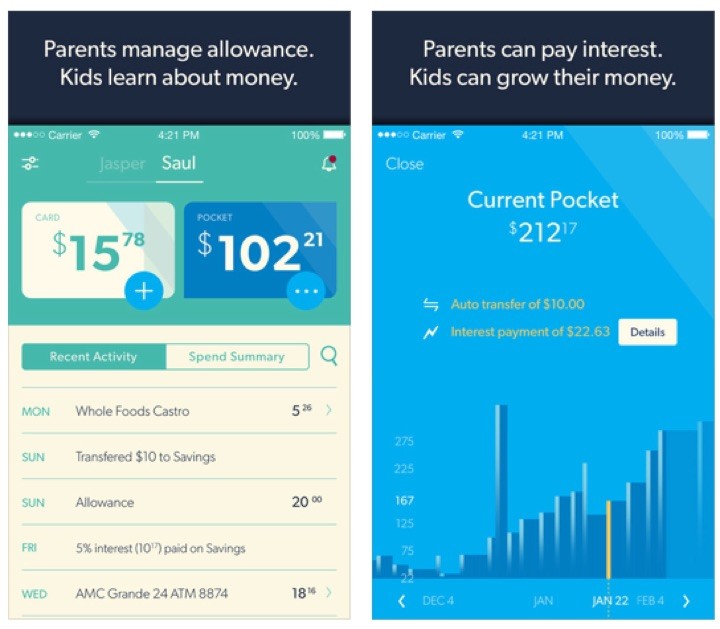
If you’re reading this, you obviously value financial knowledge and creating a secure life for you and your family. If you have kids, then you want them to develop the same skills. The NYT bestseller book The Opposite of Spoiled explored the many modern ways to teach kids about money. One recommendation for allowances is to split it up into three jars: savings, giving, and spending.
For that saving jar, an additional hack would be to pay your kids interest on their savings. For example, you could pay a monthly interest rate of 10%, which is huge in the adult world, but for a kid you need it to be large enough to be “felt” and hopefully teach them the following concepts:
- Regular, automatic savings. Let’s say you give them $10 a week that is automatically saved. (They don’t manually move money over every week, it just happens like a 401k plan.) Even with no interest, two and half months later, they’ll have a hundred bucks!
- Passive income. Now you could introduce the concept of paying interest. When they see their $100 pay $10 in interest at the end of the month, perhaps they will start to understand the power of passive income. “I could keep the $100 in there and still get to spend $10 every month forever!”
- Compound interest. Now show them how they can get interest on their interest. If they start with $100, don’t take any money out, don’t save a penny more, at 10% monthly interest they will still have $314 after 12 months of compounding.
- Compound interest + regular savings! If they start with $100, don’t take any money out, keep saving another $10 a week, at 10% monthly interest they will have $549 after a 12 months of compounding. This is starting to become serious money!
- Passive income revisited. A year later, that passive income isn’t $10 a month anymore, it has become $55 a month! This would be a good time to tell you that parents pay the interest, so if you have a little Warren Buffett at home you should set a cap on interest payments upfront. 😉
There are a growing number of “allowance apps” to cater to this market, but Nickel (iOS only, Android “not yet”) is one of the first services that I’ve seen implement this custom interest rate feature. Designed for kids age 8 and up, Nickel offers a reloadable debit card and a smartphone app for you and the kid. The parent can view all transactions and control things like allowance amount, one-time transfers, and interest rates.
Much like adult prepaid cards with 5% APY savings accounts, there are two buckets of money: the “Card” account which is available to spend via Mastercard debit, and “Pocket” account which earns interest. Here’s a 1-minute video explainer and some screenshots of the interest rate feature:

Finally, apps are cool, but let’s not forget the core values and character traits that lead to good behavior in general.
 The Best Credit Card Bonus Offers – 2025
The Best Credit Card Bonus Offers – 2025 Big List of Free Stocks from Brokerage Apps
Big List of Free Stocks from Brokerage Apps Best Interest Rates on Cash - 2025
Best Interest Rates on Cash - 2025 Free Credit Scores x 3 + Free Credit Monitoring
Free Credit Scores x 3 + Free Credit Monitoring Best No Fee 0% APR Balance Transfer Offers
Best No Fee 0% APR Balance Transfer Offers Little-Known Cellular Data Plans That Can Save Big Money
Little-Known Cellular Data Plans That Can Save Big Money How To Haggle Your Cable or Direct TV Bill
How To Haggle Your Cable or Direct TV Bill Big List of Free Consumer Data Reports (Credit, Rent, Work)
Big List of Free Consumer Data Reports (Credit, Rent, Work)
With just the initial $10 investment and a monthly interest rate of 10%, your little Buffett, Jr. will have $927, 090 in his piggy bank after 10 years. He could buy a few toys with that.
Hahaha, if my kid could get to $1,000 without spending it, I would call that a worthwhile lesson. Then I’d cut his interest rate citing the terms and conditions on balances $1,000 and over 🙂
Nickle is interesting, but at $5/month (per child!), I’d rather just use a Google Doc Spreadsheet for this concept. Plus, my kids have Android devices.
The most compelling part of Nickle is the debit/credit card. I’ve had a hard time finding any banks that will offer kids (at my kids’ ages – 12/11) anything like that. Most of them have age minimums that are several years higher than my kids are. My credit union rep even acted like we were insane for even asking.
I want my kids to have some understanding of the concept of spending “virtual” money. I feel like it’s a lot easier to understand limited amounts of cash (and that they have a pretty good grasp on that) when deciding to buy something or not, but the credit card is harder to understand – hence wanting to give them some exposure now.
I agree, the $5 a month is a drawback, but the real debit card feature is probably the main reason for the added fee. Debit cards mean they need real support staff, financial audits, etc. I would also agree with you, sometime in the teenage years kids can probably handle a debit card and the idea of spending non-cash money.
I plan to start with physical month first, so they can see for example their unspent $20 earn another $1 or $2 every month. Do you do something like that? If so, how has it worked out?
I guess every kid is so different, but with ours we’ve actually had the problem of them not wanting to spend money at all. Encouraging them to save isn’t the problem – they have been aggressive savers without interest factoring in. We’ve been trying to encourage them to spend and to think of money as something valuable because of what it can be used for – and they just keep saving it. They’ve always been more on the “wow, that’s too expensive, let’s do without” side of splurging.
I don’t think this is healthy, though – I think it’s just based out of almost as much of a misunderstanding of how money works as the kid who compulsively tries to buy every candy bar or cheap toy.
We’re actually considering moving to a much bigger allowance, with the understanding that it covers necessities (mainly clothes, but also special school events, birthday presents for friends, etc) for them now that they are hitting teen years and a move toward us not (directly) buying them these things. We’re hoping that will help them work to spend and budget for needs and wants – although I can imagine a scenario where both of them happily wear threadbare clothes to avoid spending money.
We haven’t fully worked out a plan, but pushing money into a jar hasn’t been working, so we’re thinking of going more virtual (hence the spreadsheet comment). They’ve missed so many allowances because physical money’s a pain to deal with that Family Bank of Spreadsheet (backed by the Family Deposit Insurance Commitment) has been getting more and more compelling.
As for the debit card fee – I get that it adds costs, and since this isn’t just an offering from a normal bank they have to offset their costs somehow. The problem is I can go to any number of banks and get a credit debit card for free. I’m too much of a cheapskate to pay for a slick app on top of a pretty normal product. That said, I’d probably at least check it out if they supported Android.
Can you link them to a credit card? Get one in your name with like a 500$ max and add them as a secondary card with the understanding it’s basically theres.
Bonus: this adds to the duration of their credit history which is a FICO factor
I am a big fan of paying your children an allowance, Financial literacy is so low and an allowance is a great way to teach them about money.
The one drawback is it can be time consuming. Thanks for the tip on the apps. I will check them out and see if I can save a little time.
FamZoo has been a round for a while doing this same thing. But, as with Nickel, it costs money and therefore I will be passing. I’d rather my kid have that five dollars each month than paying that much each year. http://famzoo.com/